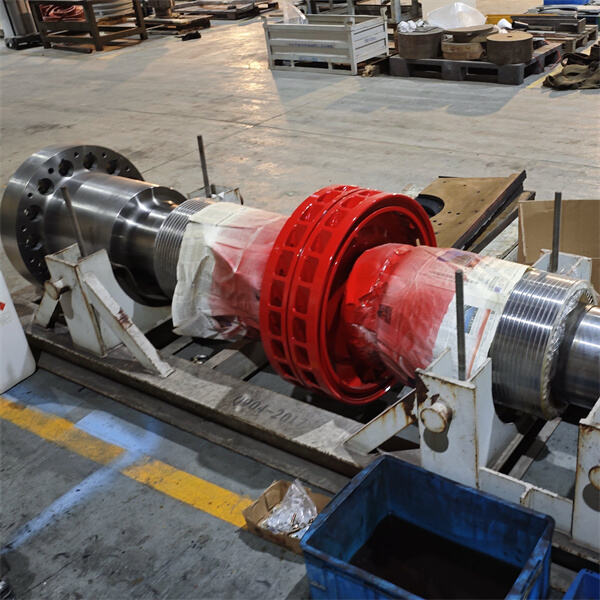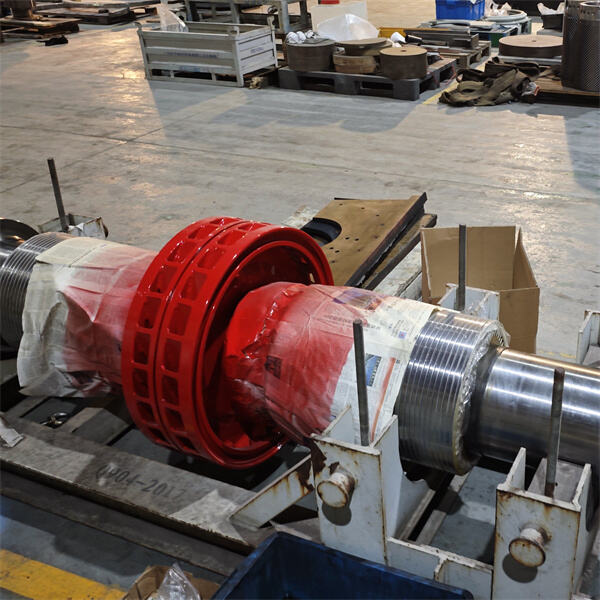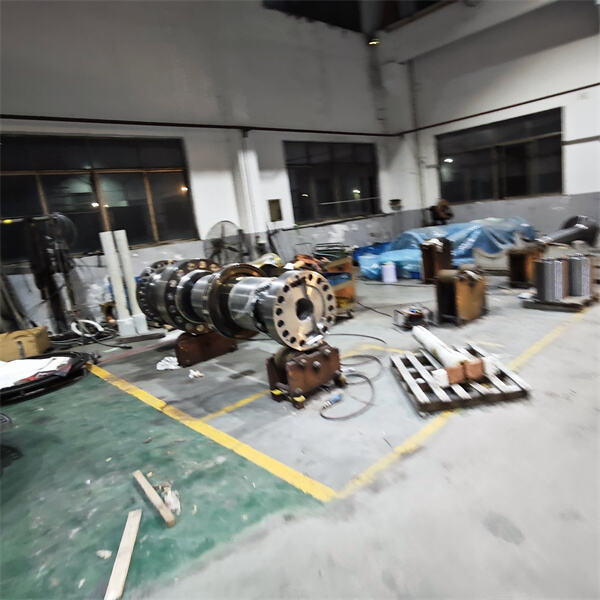Ang synchronous condenser ay isang pangunahing bahagi na tumutulong upang mapanatili ang katatagan at matiyak ang maaasahang operasyon ng mga power system. Ito ay nagagawa sa pamamagitan ng pag-convert ng elektrikal na enerhiya, ang uri na ginagamit upang paganahin ang ating mga tahanan at gadget, sa mekanikal na enerhiya. Ang mekanikal na enerhiyang ito ay ginagamit upang pamahalaan ang isang electrical power grid na namamahagi ng kuryente sa isang malaking bilang ng mga gumagamit. Sa kaso ng isang synchronous condenser, mayroong tatlong pangunahing bahagi na gumaganap ng function na ito sa konsiyerto: Ang rotor, ang stator at excitation system.
Ang umiikot na bahagi ng makinang ito na konektado din sa power grid ay tinatawag na rotor, kasama ang produkto ni Rich Slip ring collector ring. Isipin ito bilang isang cog sa isang umiikot na gulong na nagpapagana sa system. Habang ang stator ay isang nakatigil na bahagi. Nakaupo ito at hindi gumagalaw, na inatasan sa paglikha ng kuryenteng ipinapadala nito sa grid. Ang huling ngunit hindi bababa sa ay ang tinatawag na excitation system na kumokontrol sa dami ng electrical power na ibinibigay sa rotor. Sa ganoong paraan, maaari itong magbigay ng mga hangganan sa kung gaano karaming enerhiya ang gagastusin at ang mga bagay ay gagana lamang.
Ang mga synchronous condenser ay may iba't ibang gamit sa mga electric power system, pareho sa air heat exchanger binuo ni Rich. Pangunahin sa mga tungkuling ito ay ang pagbabalanse ng power grid. Sa pinakamaraming oras ng paggamit ng enerhiya, gaya ng kapag ang lahat ay naka-air condition nang buo sa isang mainit na araw, maaari itong lumikha ng hindi matatag na grid ng kuryente. Ang kawalang-tatag na ito ay maaaring magresulta sa pagkawala ng kuryente na nag-iiwan sa mga tao na walang kuryente, at mga brownout kung saan nababawasan ang kuryente ngunit hindi ganap na nawawala. Ang isang kasabay na condenser ay sumisipsip (o naglalabas) ng reaktibong kapangyarihan kapag kinakailangan upang makatulong na mapanatili ang katatagan ng grid. Ang reaktibong kapangyarihan ay sobrang enerhiya lamang upang mapanatili ang isang sistema sa ekwilibriyo.
Ang synchronous condenser ay may isa pang mahalagang gawain — upang mapanatili ang antas ng boltahe sa isang paunang natukoy na rate. Ang boltahe ang dahilan kung bakit gumagalaw ang kuryente sa mga wire Ang pagbaba ng boltahe sa power grid ay maaaring maging problema at ang masyadong mataas na boltahe ay makakasira sa mga nakakonektang makina/device. Upang itama ito, ang dami ng reaktibong paggamit ng kuryente ay maaaring kontrolin gamit ang isang kasabay na condenser upang matiyak na ang boltahe ay nananatili sa loob ng tolerance. Ang pagbabalanse na ito ay kritikal sa parehong kaligtasan ng lahat at sa maayos na pagtakbo nito.

Mga Pros and Cons Ng Synchronous Condenser na Paggamit Sa Electric Power Systems
Nakakatulong ito sa pagpapanatiling stable ng power grid: Isa sa mga pangunahing positibo ng pag-iimbak ng enerhiya, katulad ng produkto ng Rich tulad ng Singsing ng kolektor ng kuryente. Ito naman ay nakakatulong upang maiwasan ang mga blackout at brownout na maaaring mapanganib, magastos, at isang malaking abala para sa lahat ng partido. Ang isang malakas na argumento sa pabor nito ay ang boltahe ay maaaring mas mahusay na kontrolado. Pinoprotektahan nito ang buong mga makina at gadget na nangangailangan ng walang patid na kapangyarihan, sa gayo'y napipigilan ang pinsala sa mga kaluluwa ng kagamitang ito, pinapanatili silang buhay hangga't maaari.

Ang synchronous condenser ay dapat na regular na suriin para sa mga potensyal na isyu habang ang machine na pinag-uusapan ay gumagana at gumagana, pareho sa Pinagsamang sistema ng kontrol at pagsubaybay nilikha ni Rich. Maaaring may mga kakaibang ingay o vibrations na nagmumungkahi na maaaring hindi gumagana nang maayos ang isang bagay. Ang mga paglihis ng boltahe o frequency ay mga senyales din ng sirang motor na de koryente. Ang mga potensyal na problemang ito ay dapat na matugunan kaagad, upang hindi makapinsala sa kagamitan o sa mismong grid-system. Ang pagpapanatili ng iyong buong system ay mahalaga sa pagpapanatiling ligtas at mahusay na paggana nito.

Sa bawat kaso, kailangan ng kasabay na condenser para maiwasan ang mga problema sa kuryente at blackout, katulad ng produkto ni Rich Mga palikpik na pampalamig ng hangin. Ang isa sa mahahalagang function na ginagampanan nito ay upang i-throttle ang dalas at boltahe ng isang power grid. Pinipigilan nito ang pagkawasak ng mga makina sa pamamagitan ng pagsipsip ng mga spike o trough sa kapangyarihan, at nakakatulong upang maiwasan ang pagkaputol ng suplay ng kuryente. Dahil sa function na iyon, sa pamamagitan ng pag-iniksyon o pagkonsumo ng reactive power kung kinakailangan, ang form na ito ng synchronous condenser ay maaaring suportahan ang pangkalahatang seguridad ng grid ng kuryente na tinitiyak ang available na kuryente kung saan kinakailangan.
Synchronous condenser means is staffed by experienced technical professionals, production and management staff for process control and guidance this really is certainly technical installation because well as commissioning plus inspection. Ang serbisyo pagkatapos ng benta ay may hiwalay na pangkat na may kontrol sa pagsusuri ng mga problema pagkatapos ng benta, mabilis na interbensyon at paglutas ng mga dilemma sa site bilang mga pangmatagalang pagpapahusay patungo sa disenyo ng system.
Ang ShangHai Rich M at E Manufacturing Co., Ltd. ay itinatag noong 1998, ay isang Synchronous condenser na paraan. Pagkatapos noon, naging producer na ito ng isang hanay ng mga item, kabilang ang mga cooler at power collection ring, water treatment system, railway maintenance, intelligent diagnosis, online monitoring, at iba pang system at produkto.
Ang kumpanya ay palaging gumagamit ng teknolohikal at Synchronous condenser na paraan upang mapahusay ang pagiging mapagkumpitensya ng mga core nito. Ang taunang mga gastos sa pananaliksik at pagpapaunlad ay nagkakahalaga ng limang porsyento ng mga benta. Ang kumpanya ay mayroon ding kawani ng mga propesyonal, mataas ang kalidad na mahusay, malikhain at pragmatikong mga mananaliksik at developer. Ang mga tauhan ng engineering at teknikal ay higit sa 20%.
Ang mga benta ay may kawani ng may karanasang teknikal na koponan Ang ibig sabihin ng Synchronous condenser ay pamamahala upang magbigay ng kontrol sa proseso at teknikal na patnubay para sa pag-install bilang karagdagan sa pagkomisyon at inspeksyon. Ang mga serbisyo sa pagbebenta pagkatapos ng benta ay nagsasama ng isang espesyal na pangkat ng pagsusuri sa isyu pagkatapos ng benta, mabilis na pagtugon at solusyon ng mga isyu sa lugar at pangmatagalang pagpapabuti tungkol sa disenyo ng system ng produkto.


Copyright © ShangHai Rich M & E Manufacturing Co., Ltd. Lahat ng Karapatan ay Nakalaan - patakaran sa paglilihim